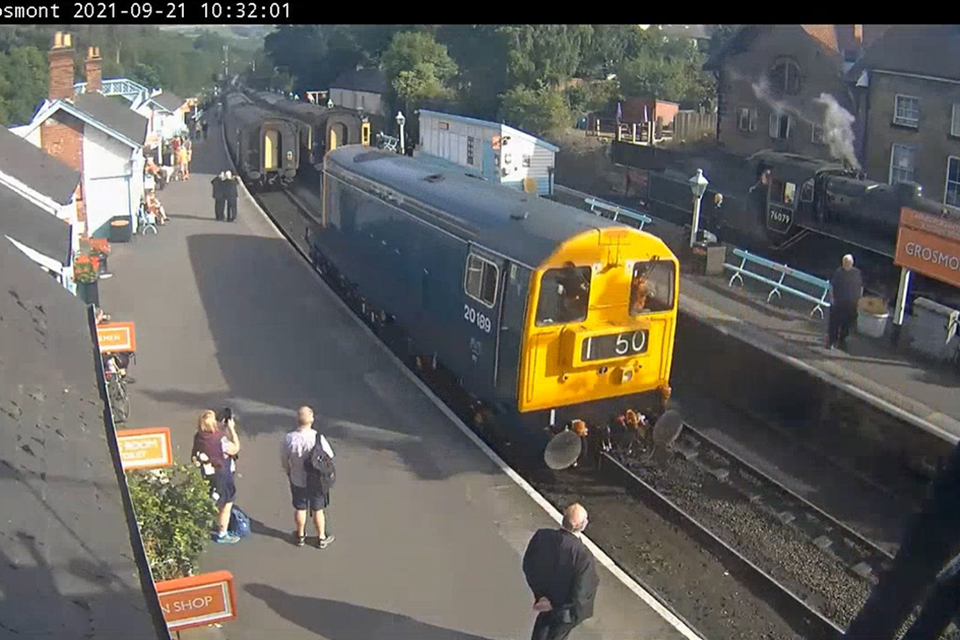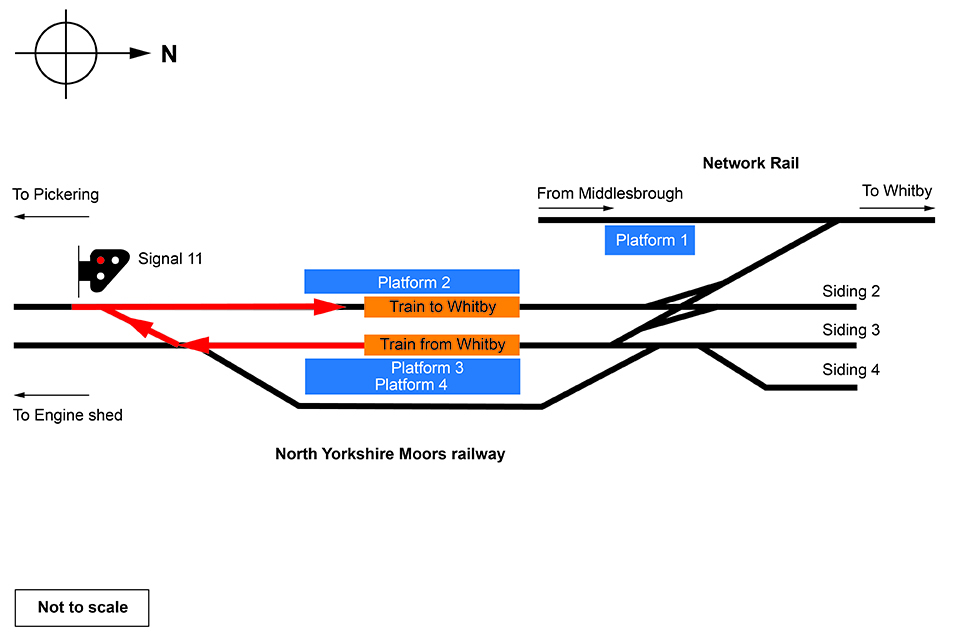Collision between a locomotive and a passenger train at Grosmont, 21 September 2021
Published 23 December 2021
1. Important safety messages
This accident demonstrates the importance of train drivers that are undertaking permissive moves into sections occupied by another train doing so at speeds that:
-
allow them to stop in the distance that they can see to be clear ahead
-
take account of any limitations of visibility from the active driving position due to the type of rolling stock and the layout of the location.
2. Summary of the accident
At 10:32 hrs, a class 20 diesel-electric locomotive entering platform two at Grosmont station, on the North Yorkshire Moors Railway (NYMR), collided with the rear of a stationary passenger train. The locomotive had just uncoupled from a train in platform three that had arrived from Whitby and was undertaking a movement to wait behind the train in platform two that was due to depart later to Whitby.
The locomotive entered platform two at about 10 mph (16 km/h) and was intended to stop in the section of unoccupied track behind the Whitby service. However, the locomotive collided with the rear of this train at about 5 mph (8 km/h).
Five minor injuries were reported amongst the 175 passengers on the Whitby service, and all were treated by first aiders at the scene. There was some damage to the passenger train coaches, which were removed from service for several weeks to allow inspection and repair. There was no damage to the locomotive, nor to the track or other infrastructure

Rail Accident Investigation Branch Safety digest 08/2021: Grosmont The locomotive entering platform two, just before the collision (courtesy of the North Yorkshire Moors Railway)
3. Cause of the accident
The accident occurred because the locomotive was travelling too fast to be able to stop in the distance available when the stationary coaches ahead first came into the driver’s view.
The class 20 locomotive, designed in the 1950s, is only fitted with a cab at one end. This means that a driver’s visibility of the line ahead is much more restricted when the nose end is leading, with the driver having to look through a narrow window past the side of the locomotive, in a similar manner to a driver of a steam locomotive.
The class 20 locomotive involved in the accident was privately owned and was made available for use by the NYMR while some of its own locomotives were undergoing maintenance. It was not scheduled to be used on that day but was required at short notice after the Automatic Warning System (AWS) equipment on the scheduled steam locomotive failed an operational test. AWS equipment is required for NYMR trains operating on Network Rail’s Esk Valley line between Grosmont and Whitby, and the class 20 locomotive had operational AWS equipment to allow it to operate on this section.

Driver view of the line ahead from cab-leading and cab-trailing driving positions
The driver held the competencies required to drive the steam locomotive intended to be used for the first Whitby service that day. Although he had held the relevant competencies to drive diesel-electric locomotives, such as the class 25 and class 37, for about five years, and had driven them on many occasions, he did not hold the specific competency to drive the class 20 being used as a replacement. As a result, he sought the assistance of a traction inspector to accompany him. The traction inspector’s role was not to teach the driver how to drive the locomotive but to assist him in gaining familiarity with the locomotive and its operation and to assess his competence. North Yorkshire Moors Railway explained that it considered that the traction inspector held the overall responsibility for operation of the locomotive by the driver.

Details of the move resulting in the collision at Grosmont station
The driver and traction inspector operated the class 20 on the first train on the Network Rail route to Whitby, along with a fireman and a cleaner. At Whitby, the locomotive ran round the train so that the cab was leading for the journey back to platform three at Grosmont.
Once at Grosmont, the class 20 was intended to be replaced on that train by the originally scheduled steam locomotive, which would take the train forwards to Pickering and back, over the NYMR lines not fitted with AWS. As the class 20 would be required to operate a later journey from Grosmont to Whitby, the signaller and the train crew communicated by radio and agreed that the locomotive would be stabled in siding two at Grosmont, from where it could easily be coupled to the later service.
To carry out this move, the class 20 locomotive had to move forward over the crossover, behind signal 11, and then back through platform two. However, the move to siding two was blocked by the presence of the train waiting in platform two for departure to Whitby. The signaller and crew intended that the class 20 locomotive move from behind signal 11 into the free space in platform two, behind the Whitby-bound service. The locomotive would then wait there until the Whitby train departed, before moving to siding two.
This move from signal 11 was a permissive move, where a train is authorised to enter a signalling section occupied by another train on the basis that the driver must stop before reaching the occupying train. The NYMR rule book and the signalling system allow for this move, and it is usually used when coupling a locomotive to a train that is already in the platform. The rule book requires a locomotive undertaking the move to stop a minimum of six feet from the stationary train. To avoid a collision during the move, the locomotive should be driven so that the driver can stop it within the distance ahead that they can see to be clear of obstructions.
The driver undertook the move from platform three to a position behind signal 11 with the locomotive’s cab leading. He then changed driving desks and started the move back towards platform two, with the cab end trailing, once signal 11 had cleared. He accelerated the locomotive to around the 10mph (16 km/h) speed limit for the line. The initial part of this move was on straight track, with the driver’s view of the line ahead limited by the body of the locomotive ahead of him. On approach to the platform, the line starts to curve to the right and the body of the locomotive further obscures the driver’s view ahead. A reconstruction by RAIB of the approach and entry to the platform showed that the driver would only have been able to see the rear of the last coach of the train ahead when the front of the class 20 was approximately 16 metres from it.
The traction inspector stated that he recognised the locomotive was travelling a little too fast for the visibility as it entered the platform. However, before the traction inspector was able to suggest the driver slow down, the fireman told the driver that he thought he should slow down. The driver applied a very gentle locomotive brake as the front of the locomotive entered the platform, 27 metres from the rear of the train ahead of it. The locomotive only started to slow down about 20 metres later, after the driver significantly increased the brake application, probably in response to the fireman’s request. By this time, the coaches ahead had come into the driver’s view, and he moved the train brake into the emergency position. However, although braking slowed the locomotive to around 5 mph (8 km/h), it collided with the rear of the stationary train.
Following the accident, the driver of the train stated that, although he was aware of the train standing in platform two, he thought that it was further along the platform and that there was more space in which to bring his locomotive to a stop. It is also possible that the limited forward visibility compared to that from the class 25 and class 37 diesel locomotives, and the driver’s unfamiliarity with driving this locomotive, affected his perception of the locomotive’s speed and his decision making.
RAIB considers it is likely that these factors combined to cause the driver to enter the platform at a speed from which he was unable to stop in time to avoid a collision. Although there were four people in the cab of the locomotive when the accident occurred, RAIB has found no evidence to suggest that this caused a distraction to the driver.
During its preliminary examination, RAIB found that NYMR was unable to provide documentary evidence that the traction inspector involved in the accident held the relevant driving competency for the class 20 locomotive. This is of concern as it means that the class 20 was operated on Network Rail’s infrastructure with neither the driver nor the traction inspector being able to demonstrate the relevant competence for that class of locomotive. The traction inspector had worked on NYMR since 1997 and had been a volunteer for 23 years prior to that. He had maintained and driven all the diesel locomotives that NYMR operated. The Office of Rail and Road (ORR) issued an improvement notice on 7 October 2021 requiring the railway to be able to demonstrate the competence of its drivers for operation on both its own infrastructure and on Network Rail’s Esk Valley line.
4. Previous similar occurrences
RAIB report 35/2007 (Collision at Swanage station) describes the collision between a diesel locomotive and a set of coaches that were stabled in a platform on a heritage railway. The locomotive was being driven from its rear cab, and the resulting lack of visibility contributed to the collision. The recommendations made included avoiding driving locomotives from the rear cab, where there is a choice, and planning moves to avoid the risk of collision.
RAIB report 02/2017 (Collision at Plymouth station) describes a collision between two passenger trains in the course of a permissive move into an occupied platform. A recommendation was made to the train operating company relating to driver training on permissive moves, and to Network Rail on the management of operational risk during authorised permissive moves. It also highlighted a learning point for drivers about undertaking permissive moves at a speed at which they can stop short of any obstructions, taking account of any sighting limitations.
RAIB report 08/2019 (Collision between road-rail vehicles at Cholmondeston) describes a collision that resulted from a vehicle with poor visibility of the line ahead being driven at a speed inconsistent with that visibility. The learning points from this investigation flagged the importance of drivers recognising any visibility limitations when driving such vehicles

